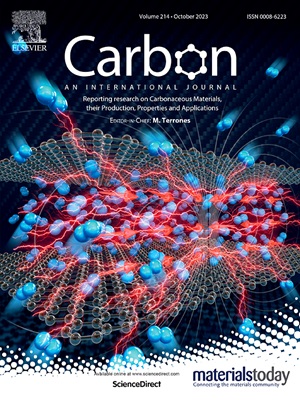NC@TiO2微波吸收微球:壳体厚度控制与电磁性能评价
IF 10.5
2区 材料科学
Q1 CHEMISTRY, PHYSICAL
引用次数: 0
摘要
碳材料吸波性能的提高往往受到其组成均匀性和阻抗不匹配的限制。本工作提出了一种通过在碳材料上引入TiO2过渡层来增加非均相界面和改善阻抗匹配的策略。以氮掺杂碳(NC)为前驱体,采用一步沉淀法合成了聚丙烯腈(PAN)微球。随后,通过酸化、定向水解和碳化处理,制备了核壳结构的二氧化钛包覆NC微波吸收剂(NC@TiO2)。本研究系统地研究了PAN与钛酸四丁酯(TBT)投料比的变化对所得材料形貌、组成和吸波性能的影响。当TBT与PAN的体积质量比为0.125:1时,复合材料在厚度为2.5 mm时的反射损耗最小为- 63.8 dB,有效吸收带宽(EAB)为5.7 GHz。调整厚度为1.8 mm, EAB扩展到6.2 GHz。我们的研究表明,半导体过渡层对碳材料的微波吸收性能有很好的影响,适当的厚度可以显著提高材料的损耗能力。本工作为其他碳基吸波材料的设计提供了可行的参考。本文章由计算机程序翻译,如有差异,请以英文原文为准。
NC@TiO2 microwave-absorber microspheres: control of shell thickness and evaluation of electromagnetic performance
The enhancement of microwave-absorbing properties in carbon materials is often constrained by their homogeneous composition and impedance mismatching. This work proposes a strategy to increase the heterogeneous interface and improve the impedance matching by introducing the TiO2 transition layer on carbon materials. Polyacrylonitrile (PAN) microspheres were synthesized via one-step precipitation polymerization as nitrogen-doped carbon (NC) precursors. Subsequently, core-shell structured TiO2-coated NC microwave-absorbing agents (NC@TiO2) were fabricated through a sequential process involving acidification, directed hydrolysis, and carbonization treatments. The study systematically investigated the effects of varying the feeding ratio of PAN to tetrabutyl titanate (TBT) on the morphology, composition, and microwave-absorbing properties of the resulting materials. When the volume-to-mass ratio of TBT to PAN was 0.125:1, the composite exhibited a minimum reflection loss of −63.8 dB and an effective absorption bandwidth (EAB) of 5.7 GHz at a thickness of 2.5 mm. Adjusting the thickness to 1.8 mm extended the EAB to 6.2 GHz. Our study suggests that semiconducting transition layers have an excellent effect on the microwave absorption performance of carbon materials, and the appropriate thickness can significantly improve the loss capability of the material. This work provides a feasible reference for designing other carbon-based microwave-absorbing materials.
求助全文
通过发布文献求助,成功后即可免费获取论文全文。
去求助
来源期刊

Carbon
工程技术-材料科学:综合
CiteScore
20.80
自引率
7.30%
发文量
0
审稿时长
23 days
期刊介绍:
The journal Carbon is an international multidisciplinary forum for communicating scientific advances in the field of carbon materials. It reports new findings related to the formation, structure, properties, behaviors, and technological applications of carbons. Carbons are a broad class of ordered or disordered solid phases composed primarily of elemental carbon, including but not limited to carbon black, carbon fibers and filaments, carbon nanotubes, diamond and diamond-like carbon, fullerenes, glassy carbon, graphite, graphene, graphene-oxide, porous carbons, pyrolytic carbon, and other sp2 and non-sp2 hybridized carbon systems. Carbon is the companion title to the open access journal Carbon Trends. Relevant application areas for carbon materials include biology and medicine, catalysis, electronic, optoelectronic, spintronic, high-frequency, and photonic devices, energy storage and conversion systems, environmental applications and water treatment, smart materials and systems, and structural and thermal applications.
 求助内容:
求助内容: 应助结果提醒方式:
应助结果提醒方式:


